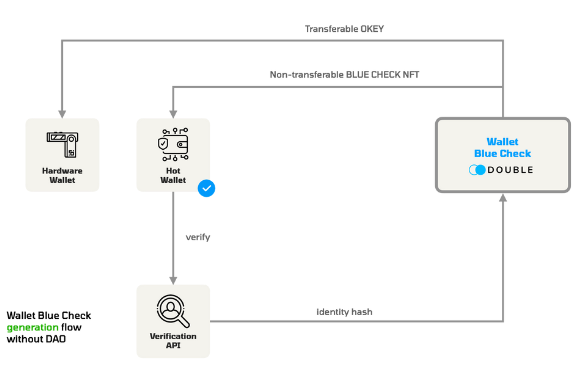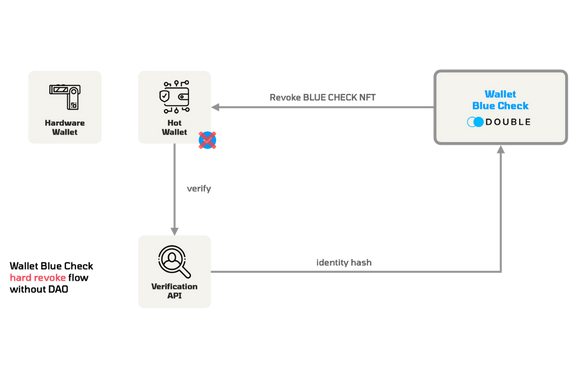Vitalik Buterin, Puja Ohlhaver, and E. Glen Weyl proposed the idea of SoulBound Token in《Decentralized Society: Finding Web3's Soul》.
This can be a game-changer in the future development of Web3. Soulbound tokens (SBT) are non-transferable, publicly-verifiable digital tokens that can act as a type of CV for web3 users, showing an individual's memberships, credentials, and affiliations.
Instead of creating a CV that includes almost everything, including education credentials, employment history, and club memberships, the DoubleWeb3 team is proposing THE BLUE CHECK token as a light version of SBT, serving only one purpose: fraud prevention.
Blockchain is good for protecting our privacy with anonymity. But it also creates problems like project rug-pull, fraud in p2p trading, etc. The BLUE CHECK token is non-transferable in a wallet, and you can only mint your BLUE CHECK if you pass the secure and easy (~50sec) verification.
How it works
When a user passes the verification, two tokens will be minted to their wallet.
- The BLUE CHECK
- The Original KEY (OKEY)
One identity can only have one active Blue Check. Each BLUE CHECK stored the hash of their identity information (Last name, first four characters of their ID number, and date of birth). The BLUE CHECK is a non-transferable, non-tradable token that is bound with a specific wallet address. Other people can quickly check if the address is being verified or not by checking the existence of the BLUE CHECK.
The BLUE CHECK will be beneficial for p2p trading, creating an NFT project, and even the future airdrop (no projects want to drop their coins/NFTs to bots)

A compromised BLUE CHECK wallet
The BLUE CHECK can only be revoked by burning the OKEY; this process is irreversible and can only be done once.
Once the BLUE CHECK is revoked, the user with the same personal information can re-mint the BLUE CHECK.
Hence, we suggest all users transfer their OKEYs to a hardware wallet immediately after minting to protect their BLUE CHECK.

HARD Revoke
If users lose all their BLUE CHECK and OKEY, they can only provide their personal to DoubleWeb3 to do a HARD revoke. After comparing the hash of their personal information, DoubleWeb3 will initiate the HARD revoke and destroy both the BLUE CHECK and the OKEY.

The Future Development of The BLUE CHECK
Selective Display
For now, there is no information displayed on the BLUE CHECK. In the future, users can choose to display some info on The BLUE CHECK publicly or grant certain parties to check part of their identity information. For example, a DEX wants to ensure its users are not coming from specific restricted locations. Or an NFT trader wants to avoid trading with sellers from North Korea.
DAO Selected Verification API
The BLUE CHECK verification relies on a trusted 3rd party for now. After setting up the DAO, we should select a group of verification partners to do the verification for users. And all information should be encrypted by private keys shared among the DAO committee.
DAO HARD Revoke
DoubleWeb3 now does the HARD Revoke for users upon request, and a DAO should replace this process as a charged service. After appointing a Hard Revoke committee. Users can submit their hard-revoke requests, and the committee will handle each request with an on-chain record.